Today, we are going to talk about today’s typical military rifle, and the semiautomatic (one shot per trigger pull) civilian versions of these rifles. Most people who don’t own firearms have some pretty strange misconceptions about these. These misconceptions arise from what they see in the Media and Hollywood. Those that do own firearms (43% of households) wonder why these misrepresentations continue for year after year. Actually, they don’t “wonder” about this, because they already know the answer.
The standard military rifle in World War I was a bolt-action rifle that used a relatively large cartridge, designed to kill a man-sized (which is about the same as a deer-sized) target at long range. In the case of the U.S., this was the .30-06 cartridge. The “thirty-aught-six” was introduced by the U.S. military in 1906, and became a standard deer-hunting cartridge. The caliber (diameter) was 0.30 of an inch. In a bolt-action rifle, a bolt needs to be pulled back and pushed forward between each shot. This removes the spent casing and loads the next cartridge. In general, rifle cartridges have a relatively small diameter, only .30 caliber, with a lot of propellant behind it so that it is effective at long range. A pistol cartridge typically has a larger diameter bullet, like .38, 9mm or .45, with much less propellant. This is to provide effective stopping power at short range, with much less recoil than a rifle cartridge.
Most people would consider a WWI-era rifle to be pretty nonthreatening, although it is an effective military weapon even today.
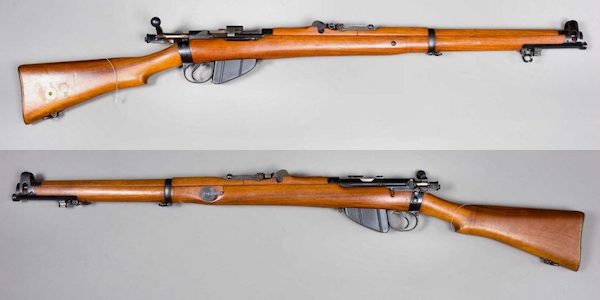
Machine guns have been around since the Maxim Gun of 1884. They proved highly effective in World War I. They used standard rifle ammunition, and thus were effective at long range. But these were very large and heavy.
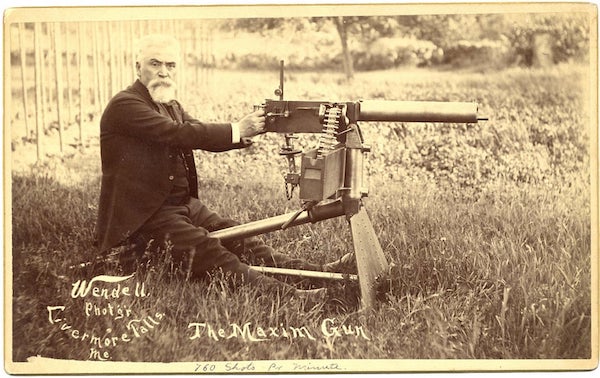
Toward the end of WWI, inventors focused on the idea of a lightweight, handheld machine gun. The result of this was the “submachine gun,” which used pistol ammunition. The classic of this era was the Thompson submachine gun, which used cartridges designed for the .45 automatic pistol.
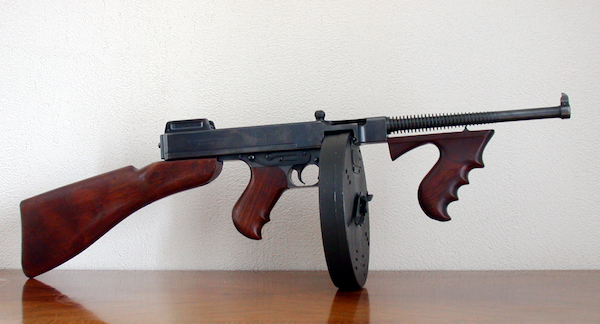
The war ended before this could be put into use, but it became popular among gangsters in the Prohibition Era. Since it used dinky pistol ammunition, it was effective only at close range.
In World War II, the basic battle rifle used the same .30-06 deer hunting cartridge from WWI, but in a semiautomatic rifle. This eliminated the need to pull the bolt back and forth. It reloaded itself. This was the M1 Garand.
Most people would not consider this rifle very threatening, although it is a highly capable military weapon.
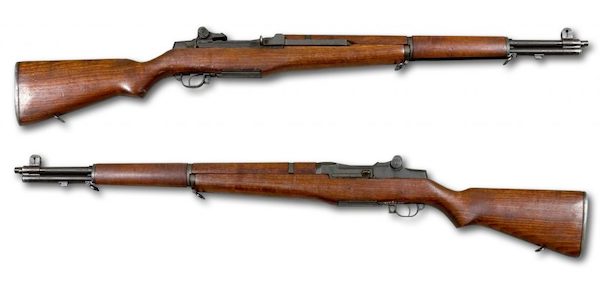
The Thompson submachine gun was also used in World War II, where it was effective at close range against numerous targets, such as a trench or fortification. But, since it used a different type of ammunition, and was not useful at long range, it was problematic. This prompted the search for something that could be used at long range, but which also had the full-auto capability of the Thompson. One of the first attempts to combine these features was the German StG 44. Invented in 1944, it did not see much use in World War II. When the engineers presented Adolph Hitler with a prototype, he called it the “Sturmgewehr,” which is translated as: “assault rifle.” Hitler had a knack for catchy terms. He also invented the words “Volkswagen” and “Blitzkrieg.”
This basic idea was adopted in Russia as the AK-47 (invented in 1947). The U.S. used the big rifle cartridges in a full-auto-capable rifle in the M14, the standard battle rifle of the 1960s. But, in 1970, the U.S. adopted the AR-15, which became the M16.
The common characteristics of the “assault rifles” (STG-44, AK-47, AR-15) were an “intermediate” cartridge that sat between a big, powerful rifle cartridge and a dinky pistol cartridge; and “select fire,” which is a switch that toggles between single-shot, possibly a three-shot burst, and full auto. These “intermediate” cartridges are the 7.62x39mm (for the AK-47) and the 5.56 NATO (for the AR-15). 7.62mm is the same as .30 caliber. 5.56mm is the same as .22 caliber. So, the 7.62×39 used the same .30 caliber as the .30-06, but with much less propellant and a smaller projectile. The 5.56 NATO used a much smaller caliber (.22), but with a relatively large amount of propellant for the very small projectile.
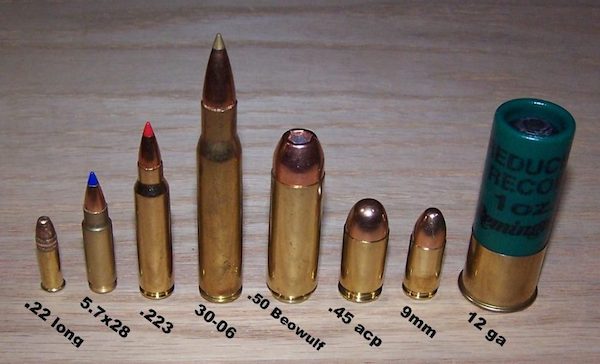
The 5.56 NATO is basically the same as the Remington .223. Here we can see the 45ACP used in the Thompson, the 9mm used in the Uzi submachine gun, the 30-06 used in the M1 Garand, the .223 used in the AR-15, and the dinky .22LR cartridge used in small game rifles. Clearly, the .223 (5.56 NATO) is “intermediate” between the 30-06 battle rifle/deer hunting cartridge and the 9mm pistol cartridge. The projectile in the 5.56 NATO is the same caliber (diameter) as in the .22LR, which is used to hunt squirrels. But, it has a lot more propellant, which makes it effective at long range.
In other words, the 5.56 NATO used in the AR-15 is a very dinky cartridge, for a battle rifle. Since the 30-06 served as an effective deer hunting cartridge, it should be no surprise that the 5.56 NATO is considered too dinky for hunting deer. When hunting deer, you want to kill it with one shot, not just wound it. Several States prohibit the use of the .223/5.56 NATO for deer hunting. For hunters, the .223 is basically a “varmint” cartridge for game such as raccoons or coyote.
In the 1950s, the 30-06 was replaced by the 7.62x51mm NATO, which was the standard battle rifle cartridge for the late 1950s and 1960s. It has basically the same characteristics as the 30-06, but a little modernized.
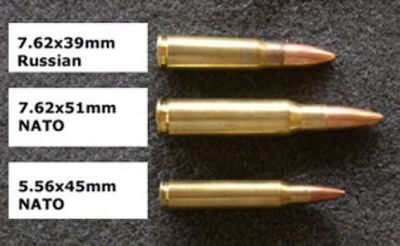
We can see that the 7.62 NATO is much larger than the “intermediate” 7.62x39mm used in the AK-47, and the 5.56 NATO used in the AR-15. In fact, the projectile in the 7.62 NATO is nearly three times the weight of the projectile in the 5.56 NATO.
The idea was that these smaller cartridges would allow the use of handheld full-auto fire, like the submachine guns which used pistol cartridges. But, this didn’t really work that well. With the larger cartridges, the “assault rifles” were very hard to control using full auto. Here is a video showing the use of the AR-15 and AK-47 in full auto. As you can see, even these trained users can barely “hit the side of a barn,” or, in this case, a cinderblock wall, at close range. The AK-47 user actually refuses to use full auto, even when explicitly asked to do so, arguing that it is not really possible to do this at all. The M16 user uses a waist-level stance which better stabilizes the rifle, but which disallows any meaningful aim. This is why proper machine guns (like the Maxim) are mounted on tripods.
Just for comparison, here is a look at the Uzi submachine gun, which uses the far smaller 9mm pistol cartridge. It is much easier to control, but even so, full auto fire doesn’t necessarily accomplish much. The Uzi, invented in the late 1940s, was phased out largely due to its short 50m effective range.
Here is the same fellow, now using the Glock 17 pistol which uses the same 9mm cartridge.
What actually happened when the AR-15 (M16) was used in battle in Vietnam was that soldiers wasted colossal amounts of ammunition “spraying and praying.” This was worse than useless: soldiers could easily run out of ammunition (at 600 rounds per minute, a 30-round magazine is exhausted in three seconds), in which case they were dead. During the Vietnam War, U.S. soldiers used 50,000 rounds of ammunition for each enemy fatality.
The “assault rifle” concept was, apparently, a failure. Or, not quite: what they discovered instead was that there were a lot of advantages to the “intermediate” round, but full auto capability was not one of them. Mostly, the advantage was that they were light, and small. A soldier could easily carry much more ammunition, either in a pack, or in the rifle magazine. Ten kilograms of 7.62 NATO (just try carrying that all day) was 280 rounds. The same 10kg was 620 rounds of 5.56 NATO. The standard 20-round magazine of the M14 (using 7.62 NATO) expanded to 30 rounds for the M16. Less reloading, and fewer magazines to carry. Thus, despite its dinkyness, the 5.56 NATO remains standard issue today, and we have not gone back to the 7.62 NATO for the standard battle rifle. The 7.62 NATO continues to be used in sniper rifles, and medium machine guns such as the M240.
Today, the standard U.S. Army battle rifle, the M4 Carbine, does not have full auto capability. Only Special Forces get that switch. The common grunt is not going to be allowed to “spray and pray,” although there is a three-round burst mode. U.S. military standard battle rifles haven’t had full-auto capability since 1982, with the introduction of the M16A2.
The civilian AR-15 is limited to semiautomatic (one shot per trigger pull) fire. And it uses the dinky 5.56 NATO ammunition, which is a varmint cartridge among hunters. Because of its background as the full-auto-capable “assault rifle” (thanks, Adolph), it has been labeled an “assault weapon” by zealous politicians, who want you to believe that it has full-auto capability. And, it sure looks scary!
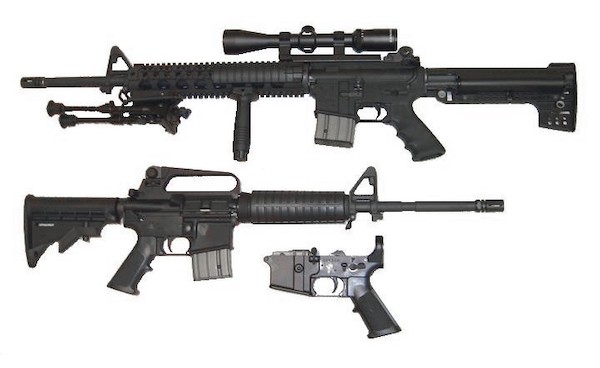
This is a much less powerful rifle than the M1 Garand used in WWII, which was also a semiautomatic rifle. Despite all this, however, it is a highly capable military weapon.
For comparison, here is the Izhmash Saiga IZ132 rifle:
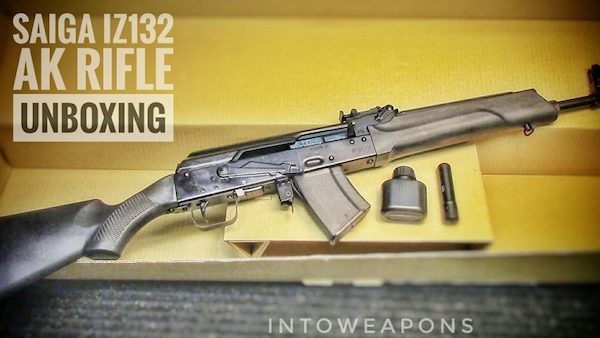
Not so scary, right? Actually, the Saiga is literally the same as the AK-47, without a pistol grip. Everything else is identical. It is legal in “assault weapons ban” states. It actually comes from the same Russian factory where Mikhail Kalashnikov first developed the AK-47. It is a semiautomatic rifle that uses a small “intermediate” rifle round.
The Springfield M1A (M14) is available today. This was the standard battle rifle of the 1960s (limited to semiautomatic fire), and uses the much more powerful 7.62 NATO cartridge. It is legal in “assault weapons ban” states.

Here are some M14s used in Vietnam during the 1960s.

The point of all this is: the “assault weapon” is a made-up term to convince you that a semiautomatic “varmint rifle” unfit for deer hunting, that uses a small “intermediate” rifle round, is full-auto-capable like the “assault rifle,” (Sturmgewehr) and too big, bad and scary for civilians to own, mostly because it has a scary pistol grip. Nevertheless, the AR-15 is, actually, a highly capable military weapon. Today, roughly 20 million out of 300+ million firearms owned by U.S. citizens are “assault weapons,” with the AR-15 of course the most popular. We have already seen that rifles in general, and especially legally-owned rifles, have very little relationship to firearm homicide (90% pistols, 90%+ illegally owned), and even not much relationship to (non-drug-or-gang-related) “mass shootings,” which themselves are such a small fraction of overall homicides as to be irrelevant, except for people’s “feeeelings” excited by mass media saturation. And of all the “assault weapons,” the focus is on the AR-15.
Why? Although the legally-owned AR15 is largely irrelevant from a crime perspective (shotguns are used in more crime, including “mass shootings”), it is the premier tool (accompanied by military-style high-capacity magazines) by which the U.S. civilian acquires the capability to resist a military-style opponent — a large, organized force that might be engaged in battles lasting hours. This could be a criminal gang or group of bandits, a drug cartel, ISIS sleeper cell, communist revolutionaries, police force or a state military, foreign or domestic. And where is this military-style opponent? Is it gathering in Mexico along the southern border? Is the Mexican government trying to convince you to hand in your AR15s? It is not. It is your own government; or rather, certain elements that influence the government. These elements appear to be highly organized, with the mass media, “think tanks” and certain politicians singing from the same songbook over a period of decades. This requires billions of dollars of funding and control of major institutions. I think that tens of millions of Americans understand this very well, and it makes them very, very nervous about giving up their firearms, and very enthusiastic about contributing to the NRA. They sense that these highly organized, well-funded elements, obviously with control of the major media and many politicians, also have plans for what they would like to do after the U.S. citizen is disarmed.

